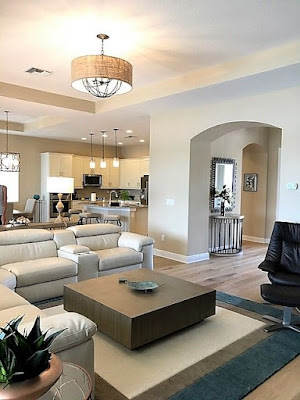You've finished the floors, painted the room, and selected some beautiful high-quality furniture pieces from one of your favorite furniture store's 16 locations. If you're like most interior decorators, you're ready to start a round of accessory shopping. Or, you already have some accessories in place, but you want more.
According to the Oxford Dictionary, "gilding the lily" means to "improve or decorate something that is already perfect and therefore spoil it." No one understands the compulsion to buy accessories better than the Baer's Furniture Design Team members. But how do you know when enough is enough? If you choose too many accessories or combine too many patterns, your room can go from a tasteful and comfortable living space to a busy, cluttered hodgepodge. We have some tips to help prevent you from gilding the lily.
Purchase Functional Accessories First
A functional accessory is anything in the room that is not solely for decorative purposes. Functional accessories include lamps and lampshades, curtains, area rugs, etc. Selecting these necessary accessories can help avoid over-purchasing and throwing off the room's balance.
In this beautiful bedroom featuring the Sag Harbor Tufted Bed, functional accessories include the end-table lamps, curtains, bedspread, and the area rug. Additional decorative accessories include the throw on the bench, decorative pillows on the bed, and wall art.
It's important to note that this is an extremely well-thought-out decorative space. While a toss pillows or wall art might not be necessary, they do make the room look great.
Stick to the Plan
We are huge advocates of vision boards to help our customers plan their decorative themes. Vision boards are an accessible way to plan your space before purchasing. However, as your design vision comes to fruition and all of the major expenditures of time and money are behind you, you may be tempted to "take chances" with accessories that, for one reason or another, didn't make it to your original design concept.
If you do decide to add or switch out accessories, avoid cluttering your space by observing the following rules :
- Use replacement accessories of the same size. Or replace one accessory with two or more smaller accessories that combine to be the same size as the original one you had in mind.
- Replace accessories with similarly-colored items. If you decide the original color you picked was wrong for the space, choose from your existing color palette.
- Solids and patterns are not the same. Prints give the illusion of a busier space.
Keep Minimalism Minimal
Minimalism does not mean "bereft of character." You can have accessories in a minimalist decorative space — just fewer than with maximalist themes. If you've selected a minimalist design, choose your accessories wisely. This living room features the Joli Collection Contemporary Sofa by Bernhardt, but it has a decidedly minimalist bent with its muted neutral colors and efficient lines. As you can imagine, adding a few accessories or colors to this sophisticated design would throw it out of balance. It's perfect in its simplicity.
Not Everything Qualifies as an Accessory
You might have a patchwork quilt that you love because it's really cozy, but it just doesn't fit with your modern, contemporary, or Mid-century Modern décor. And electronic devices, remotes, charging cords, board games, etc., should never be considered an accessory. To solve this problem, we recommend storage furniture to eliminate clutter from non-accessories.
The Sea Glass Buffet with Sand-blasted Doors in this space provides a surface for actual accessories while providing ample space for whatever items don't really go with the theme. Note the way the decorative pillow, glass bowl, and vases all pursue the same family of blue.
Use Curio Cabinets to Control Decorative Sprawl
You may have a few items that you'd like to proudly display, but don't actually fit with your living room or dining room's décor. However, a curio cabinet allows you to group together thematic or disparate items in one central location. Instead of each item having to act as its own accessory, the curio cabinet becomes an accent piece. For example, it would be difficult to find a place for the number of accessories contained in this Chocolate Cherry Curio by Pulaski Furniture. However, they all fit nicely in this lovely display cabinet. The design also discourages visitors from handling breakable objects.
Accessories are an integral part of interior design and an option you should always have in your decorating arsenal. Just remember that having too many could be just as detrimental as having too few.

.webp)
.webp)
.webp)
.webp)
.webp)

.jpeg)
.jpeg)
.jpg)

.webp)
.webp)
.webp)
.webp)






